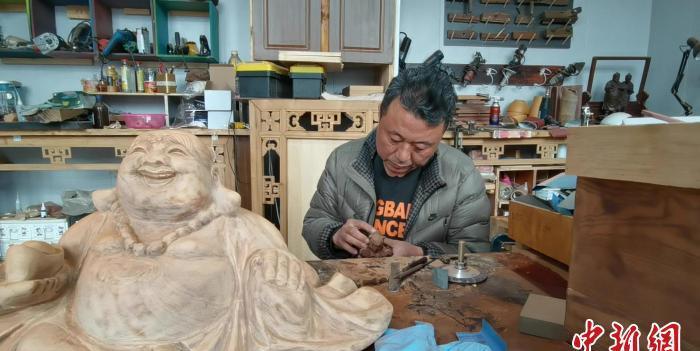
The art of wood carving is an important art form under the accumulation of Chinese culture. The picture shows wood carving artist Wang Quansheng creating. Photo by Wang Huilin
Zhongxin Network Taiyuan, March 21 Title: The Collision of Carving Knives and Wood: Seeking Oriental Aesthetics Between Square Inches
Author Gao Ruifeng
"Carving a fine piece, skill and patience are indispensable. A piece of human wood carving, depicting only the face, may require thousands of knives. On the 21st, in Liujiapu Village, Xiaodian District, Taiyuan City, Shanxi Province, in the Wood Carving Studio of Moshe, Wang Quansheng focused on his works, carving knives in his hands, and wood chips fell everywhere.
"The art of wood carving is an important art form under the accumulation of Chinese culture, which is permeated with the way of thinking and values contained in Chinese culture." Wang Quansheng said that Western aesthetics emphasize "realism", Eastern aesthetics emphasize "freehand", and Chinese wood carving art vividly expresses "Chinese charm".
Chinese wood carving art has a long history, the wood carving technology of the Qin and Han dynasties tended to mature, and the wood carving art of the Ming and Qing dynasties entered a golden period. Photo by Wang Huilin
The art of Chinese wood carving has a long history, and the Analects of Gongyechang has the saying that "decaying wood cannot be carved". The wood carving technology of the Qin and Han dynasties tended to mature, and the wood carving art of the Ming and Qing dynasties entered the golden age.
In the inheritance from generation to generation, many genres of wood carving art have been born, such as Dongyang wood carving, Chaozhou golden lacquer wood carving, Wenzhou boxwood carving, etc. Wang Quansheng introduced, "Shanxi wood carving is actually a big genre. The wood carvings preserved in the Jinshang compound represent the highest level of wood carving in residential houses in the Ming and Qing dynasties in northern China. ”
The art of Chinese wood carving contains rich connotations of Chinese culture. The picture shows the wood carving works of Shanxi wood carving artist Wang Quansheng. Photo by Wang Huilin
Shanxi is known as the "Museum of Ancient Chinese Architecture", the temples, Taoist temples, pavilions, pavilions, pagodas, etc. are scattered in the land of the Three Jins, and the ancient houses represented by the Jinshang Compound are very rich in regional characteristics, and their beams, arches, hangings, finches, cornices, doors and windows and other wood carving decorations, with diverse themes and pleasing to the eye.
In the field of collection, Shanxi wood carving is not famous, and the "famous head" is not as loud as the wood carving in Dongyang, Chaozhou and other places. The wood used in Shanxi folk wood carving is mostly mahogany, elm and other hardwoods, and the scarcity and preciousness of wood are difficult to compare with the precious famous trees such as sandalwood, yellow pear and sour branch wood used in the southern wood carving school. At the same time, in terms of industrial chain, it cannot be compared with the south.
"In terms of development, the southern wood carving is better than the northern wood carving." Wang Quansheng introduced that wood carving has a variety of carving techniques such as relief carving, circular carving, hollow carving, yin carving, and through carving, and a variety of combined carving techniques are often used in the creation, and the folk have a saying of "a thousand knives and five hundred mills".
Wood carving is the art under the tip of a knife, solidifying the soul of craftsmanship. The picture shows wood carving artist Wang Quansheng creating. Photo by Wang Huilin
In the long-term development process, Chinese wood carving art contains rich Chinese cultural connotations. Blessings, Lu, Shou, Xi and other themes of prayer and blessing, yuqiao cultivation reading, Taoyuan Jieyi, bamboo forest seven sages, twenty-four filial pieties and other ethical indoctrination themes, eight immortals, dark eight immortals, auspicious qing ping'an, bagua tu and other themes of exorcism and disaster, expressing the people's yearning for a better life.
Wood carving is the art under the tip of a knife, solidifying the soul of craftsmanship. "More than 20 years ago, when I went to Dongyang to buy wood carving crafts, the more I looked at it, the more I liked it, and I directly learned the art from my teacher." Wang Quansheng hopes to have a broader stage to better inherit and protect this ancient skill.
He said that drawing on the nutrients of traditional Chinese culture, inheriting and developing, and drawing new ideas from modern art to develop art, so that wood carving art can better present the beauty of oriental aesthetics. (End)